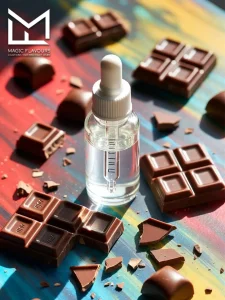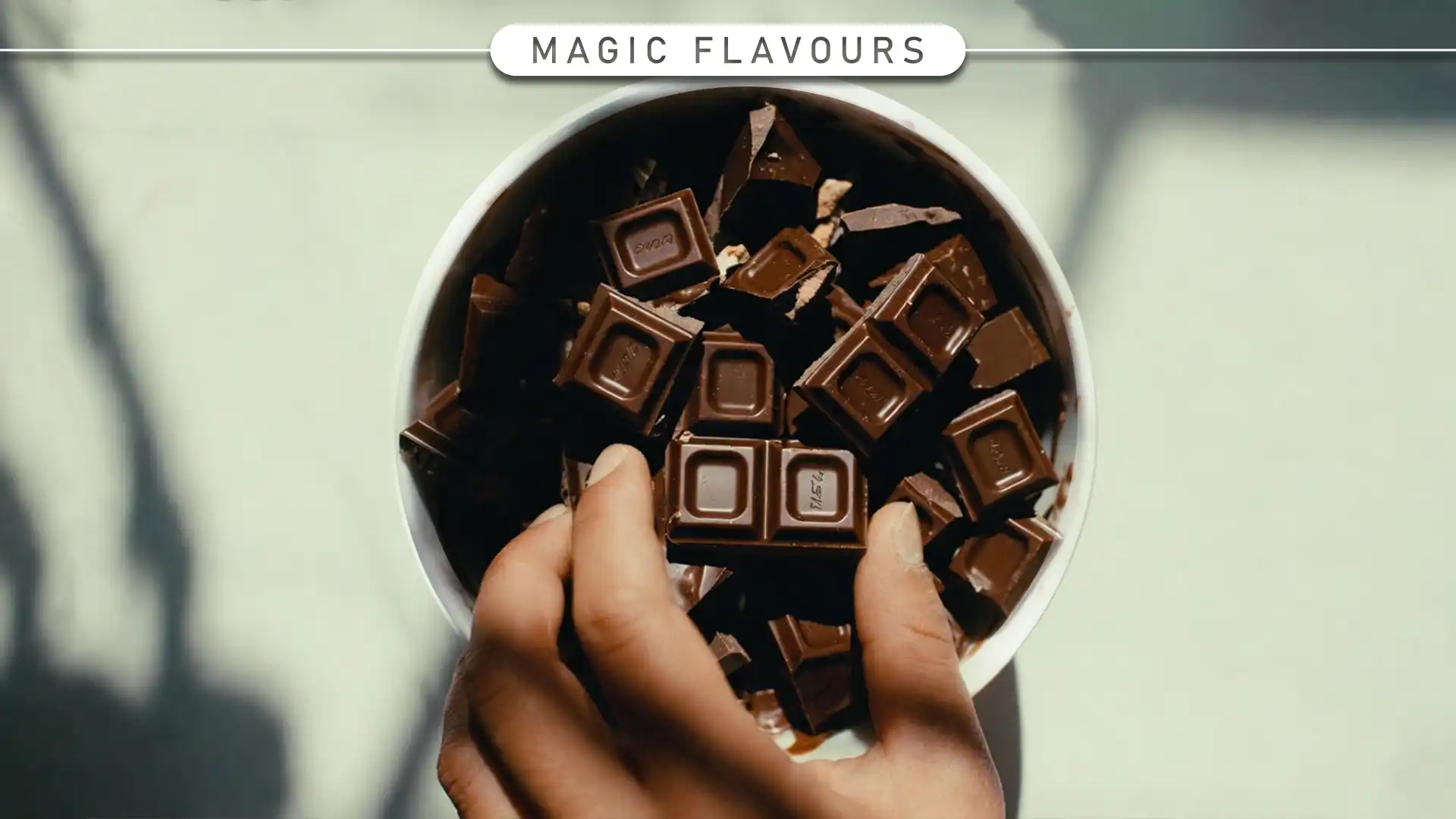1. Introduction
Artificial Chocolate Flavor: From Confectionery to Tobacco

Artificial chocolate flavor has become a versatile ingredient across multiple industries. It enhances the taste and aroma of confectionery products like candies, chocolates, and baked goods. In beverages, it adds a rich, indulgent note to milkshakes, hot chocolates, and protein drinks. The cosmetic industry also uses this flavor in lotions, bath products, and perfumes for a luxurious, sensory experience. Even the tobacco industry incorporates chocolate notes in flavored cigarettes, cigars, and e-liquids to create smoother, more appealing products. Its wide application is due to consistent flavor, cost-effectiveness, and ease of blending with other ingredients. Consumers increasingly seek products with multisensory appeal, making artificial chocolate flavor highly desirable. From sweets to beauty and tobacco, this flavor bridges indulgence and innovation. Its ability to create familiar yet unique experiences make it a staple for brands worldwide.
Overview of artificial chocolate flavor and why it’s widely used
Artificial chocolate flavor is a carefully crafted ingredient that mimics the taste of real chocolate. It provides a consistent, rich, and indulgent flavor across many products. This flavor is widely used in confectionery, baked goods, and beverages to enhance sweetness and depth. In cosmetics and personal care, it adds a luxurious, sensory appeal to lotions, creams, and perfumes. Even tobacco products use chocolate flavor to create smoother, more enjoyable experiences for consumers. Its popularity comes from cost-effectiveness, long shelf life, and versatility in combining with other flavors. Consumers enjoy the familiar yet elevated taste that artificial chocolate delivers. For brands, it offers an opportunity to innovate while meeting market demands for indulgent, multisensory products. Overall, artificial chocolate flavor remains a key ingredient across food, beverage, cosmetic, and tobacco industries worldwide.
Mention its versatility and appeal across multiple industries
Artificial chocolate flavor is prized for its versatility across multiple industries. It blends seamlessly in confectionery, beverages, and baked goods. In cosmetics, it adds warmth and indulgence to lotions, creams, and perfumes. Even the tobacco industry uses chocolate flavor to enhance appeal and smoothness in products. Its ability to pair with fruits, nuts, and spices makes it highly adaptable for different formulations. Consumers enjoy its familiar taste, while brands appreciate its consistency and cost-effectiveness. The flavor enhances both traditional and modern products, bridging heritage with innovation. From luxury chocolates to scented bath products and flavored tobacco, artificial chocolate flavor adds a sensory richness. This broad appeal ensures it remains a valuable ingredient for creative, indulgent, and market-driven product development.
2. What Is Artificial Chocolate Flavor?
Understanding Artificial Chocolate Flavor
Understanding artificial chocolate flavor begins with its chemical composition and purpose. It is designed to mimic natural chocolate taste. Key compounds include vanillin, lactones, and other aroma chemicals that create chocolate’s rich, creamy profile. This flavor provides consistency that natural chocolate cannot always offer across batches. It is cost-effective, shelf-stable, and easy to blend with other ingredients. Manufacturers use it in foods, beverages, cosmetics, and even tobacco products. Artificial chocolate flavor allows brands to create indulgent, multisensory experiences while controlling quality and intensity. Its versatility ensures it can replicate complex chocolate notes in sweet, creamy, or smoky applications. Understanding its function helps product developers innovate while maintaining consumer appeal. Overall, artificial chocolate flavor bridges taste, aroma, and texture, offering a reliable solution across diverse industries.
Definition and chemical composition (vanillin, benzaldehyde, lactones, etc.)
Artificial chocolate flavor is a blend of carefully selected chemical compounds that mimic natural chocolate taste. Key ingredients include vanillin, which provides a sweet, creamy vanilla note. Benzaldehyde adds subtle almond-like aroma that enhances richness. Lactones contribute smooth, buttery undertones, creating depth and complexity. Other aroma compounds are often included to replicate cocoa’s full sensory profile. These ingredients are combined in precise ratios for consistency across products. The chemical composition allows the flavor to remain stable in food, beverages, cosmetics, and tobacco. Manufacturers can adjust concentrations to achieve desired sweetness, creaminess, or intensity. Understanding these components helps brands create indulgent, high-quality experiences for consumers. Overall, vanillin, benzaldehyde, lactones, and other compounds make artificial chocolate flavor versatile, reliable, and widely used across multiple industries.
How it mimics natural chocolate flavor

Artificial chocolate flavor mimics natural chocolate by recreating its key taste and aroma compounds. Vanillin provides sweet, creamy notes. Benzaldehyde adds subtle almond-like aroma found in cocoa. Lactones contribute buttery, velvety undertones for depth and smoothness. Additional compounds replicate the complex bitter, roasted, and nutty notes of chocolate. These ingredients are carefully balanced to mirror chocolate’s multi-layered sensory profile. The flavor can be adjusted for sweetness, creaminess, or intensity depending on the product. In food, beverages, cosmetics, and tobacco, it reproduces the familiar chocolate experience. By combining these elements, brands deliver indulgent, consistent, and appealing flavors without relying on natural cocoa. Overall, artificial chocolate flavor offers a reliable solution that captures the essence of chocolate in versatile applications.
3. Applications in the Food & Beverage Industry
Artificial Chocolate Flavor in Foods and Drinks
Artificial chocolate flavor is widely used in foods and drinks to enhance taste and aroma. It enriches chocolates, candies, cookies, and cakes. In beverages, it adds indulgent notes to hot chocolate, milkshakes, protein drinks, and flavored coffee. The flavor blends seamlessly with fruits, nuts, and other sweet ingredients. It allows consistent chocolate taste across batches, ensuring high-quality products. Manufacturers value its cost-effectiveness and long shelf life compared to natural cocoa. It also enables innovation, creating unique dessert flavors, chocolate-infused snacks, and creative beverage formulations. Consumers enjoy familiar chocolate taste, while brands can meet market demand for indulgent, multisensory experiences. Overall, artificial chocolate flavor plays a key role in delivering rich, delicious, and reliable products in the food and beverage industry.
Confectionery: Candies, chocolates, and sweet treats
Artificial chocolate flavor is essential in the confectionery industry for creating candies, chocolates, and sweet treats. It provides rich, indulgent taste that appeals to consumers. In chocolates, it enhances cocoa notes while ensuring consistency across batches. Candies and sweet treats benefit from its ability to blend with fruits, nuts, and other flavorings. The flavor allows manufacturers to innovate with fillings, coatings, and layered confections. It is cost-effective and shelf-stable, making production easier and more reliable. Consumers enjoy a familiar yet enhanced chocolate experience in every bite. Overall, artificial chocolate flavor is a versatile, essential ingredient in creating indulgent, high-quality confectionery products that satisfy taste and sensory expectations.
Beverages: Hot chocolate mixes, flavored milk, protein shakes, and syrups
Artificial chocolate flavor elevates a wide range of beverages, from hot chocolate mixes to flavored milk. It creates rich, creamy taste that delights consumers. Protein shakes and meal replacement drinks benefit from its indulgent chocolate notes. Syrups and chocolate-flavored beverages gain consistency and depth without relying on natural cocoa. The flavor blends seamlessly with other ingredients, enhancing sweetness and aroma. It allows manufacturers to deliver a reliable, high-quality chocolate experience across all drink products. Consumers enjoy familiar, indulgent flavors in every sip. Overall, artificial chocolate flavor ensures beverages are delicious, consistent, and appealing while supporting innovation in new product formulations.
Baked Goods: Cakes, cookies, pastries, and fillings
Artificial chocolate flavor is widely used in baked goods, including cakes, cookies, pastries, and fillings. It adds rich, indulgent taste to every bite. Cakes and cookies benefit from consistent chocolate notes that enhance sweetness and aroma. Pastries and fillings gain smooth, velvety undertones that elevate texture and flavor complexity. The flavor blends well with nuts, fruits, and other complementary ingredients. Manufacturers rely on it for cost-effective, shelf-stable solutions that ensure quality across batches. Consumers enjoy familiar chocolate taste while experiencing innovative and delicious baked creations. Overall, artificial chocolate flavor is essential in creating indulgent, high-quality baked goods that appeal to taste and sensory expectations.
Dairy Products: Ice creams, yogurts, and creams
Artificial chocolate flavor enhances dairy products like ice creams, yogurts, and creams. It provides rich, creamy chocolate notes that delight consumers. Ice creams gain indulgent taste and smooth texture, appealing to all ages. Yogurts benefit from a consistent chocolate flavor that blends with fruits and other mix-ins. Creams and dessert toppings are elevated with velvety, sweet chocolate undertones. Manufacturers value its stability, cost-effectiveness, and ability to deliver consistent taste across batches. Consumers enjoy familiar yet luxurious chocolate experiences in every scoop or spoonful. Overall, artificial chocolate flavor is a versatile ingredient that transforms dairy products into indulgent, high-quality treats that satisfy taste and sensory expectations.
Advantages: Cost-effective, consistent flavor, long shelf life
Artificial chocolate flavor offers several key advantages for manufacturers and consumers alike. It is highly cost-effective compared to natural cocoa. The flavor provides consistent taste across batches, ensuring reliable product quality. Its long shelf life makes it ideal for packaged foods, beverages, and cosmetic products. Manufacturers can innovate confidently, knowing the flavor will remain stable during production and storage. Consumers benefit from indulgent chocolate experiences that meet expectations every time. The versatility of artificial chocolate flavor allows it to blend with other ingredients seamlessly. Overall, its cost-effectiveness, consistency, and durability make it a valuable ingredient across food, beverage, cosmetic, and tobacco industries, supporting both creativity and quality.
4. Applications in the Cosmetic & Personal Care Industry
Sensory Luxury: Chocolate Flavor in Cosmetics
Artificial chocolate flavor adds sensory luxury to cosmetic products, enhancing the overall user experience. It enriches lotions, creams, and bath products with indulgent chocolate notes. Perfumes benefit from its warm, sweet aroma, creating a comforting and elegant scent profile. The flavor provides multisensory appeal, connecting fragrance, texture, and emotional satisfaction. It allows brands to create luxurious, memorable products that stand out in a competitive market. Consumers enjoy the familiar chocolate aroma combined with pampering skincare experiences. Artificial chocolate flavor is stable, versatile, and blends easily with other cosmetic ingredients. Overall, it transforms ordinary products into indulgent, high-quality offerings, adding warmth, sophistication, and sensory pleasure to daily routines.
Perfumes, lotions, bath products, and creams

Artificial chocolate flavor enhances perfumes, lotions, bath products, and creams with rich, indulgent aroma notes. It adds warmth and luxury to everyday routines. Lotions and creams gain velvety, comforting undertones that elevate skin care experiences. Bath products benefit from the sweet, soothing scent that creates a spa-like atmosphere. Perfumes achieve depth and richness by incorporating chocolate notes with floral or gourmand blends. The flavor blends seamlessly with other ingredients for consistent, high-quality results. Consumers enjoy multisensory appeal, connecting scent, texture, and emotional satisfaction. Overall, artificial chocolate flavor transforms cosmetic products into indulgent, memorable experiences, enhancing luxury and consumer delight.
How chocolate flavor adds warmth, indulgence, and elegance
Chocolate flavor adds warmth, indulgence, and elegance to a variety of products. Its rich, sweet aroma evokes comfort and luxury. In foods and beverages, it creates a familiar, indulgent taste that delights consumers. Cosmetics and bath products benefit from chocolate notes that provide sophistication and sensory pleasure. Tobacco products gain smoother, more appealing flavor profiles with subtle chocolate undertones. The flavor blends easily with fruits, nuts, spices, and floral ingredients for complex, balanced experiences. Its warmth and elegance make products feel premium and memorable. Overall, chocolate flavor elevates everyday items into indulgent, multisensory experiences that engage taste, smell, and emotion, creating lasting consumer appeal.
Popularity in products marketed as “gourmet” or “luxury.”
Chocolate flavor is especially popular in products marketed as “gourmet” or “luxury.” It signals indulgence and premium quality. In chocolates, desserts, and beverages, it enhances richness and sophistication. Cosmetics and bath products use chocolate notes to create a luxurious, multisensory experience. Consumers associate chocolate aroma with comfort, elegance, and high-end indulgence. The flavor helps brands differentiate products in competitive markets and appeal to discerning audiences. Its versatility allows it to pair with fruits, nuts, spices, and other premium ingredients. Overall, chocolate flavor adds perceived value, elevates product positioning, and supports marketing efforts for gourmet and luxury items.
5. Applications in the Tobacco Industry
Sweet Smoke: Chocolate Flavor in Tobacco Products
Chocolate flavor is increasingly used in tobacco products to enhance taste and aroma. It softens harsh tobacco notes for a smoother experience. Flavored cigarettes, cigars, and smokeless tobacco often include chocolate to appeal to adult consumers. E-liquids and vape juices benefit from its sweet, indulgent profile, masking bitterness and adding richness. The flavor creates multisensory appeal by combining aroma, taste, and smoothness in every puff. Manufacturers appreciate its consistency, stability, and versatility in product formulations. Consumers enjoy a familiar, comforting chocolate note that enhances the overall tobacco experience. Overall, chocolate flavor adds warmth, indulgence, and appeal to tobacco products, making them smoother and more enjoyable while supporting creative product innovation.
Flavored Cigarettes and Cigars: Masks harshness and enhances taste
Flavored cigarettes and cigars often use chocolate flavor to mask harshness and enhance taste. It softens strong tobacco notes. The chocolate aroma creates a smoother, more enjoyable smoking experience. Consumers perceive the flavor as indulgent, rich, and comforting. It blends well with other flavor additives, such as vanilla or caramel, for complex profiles. Manufacturers rely on chocolate flavor for consistency across batches and product types. This flavor also supports product innovation, allowing unique and appealing blends for discerning smokers. Overall, chocolate flavor elevates cigarettes and cigars by improving taste, reducing harshness, and adding warmth and indulgence to the smoking experience.
Smokeless Tobacco: Chocolate flavor in chewing tobacco or snuff
Chocolate flavor is often added to smokeless tobacco, including chewing tobacco and snuff. It enhances taste and aroma. The flavor masks bitterness and creates a smoother, more enjoyable experience. Consumers perceive chocolate notes as rich, indulgent, and comforting. It blends easily with other flavorings, such as vanilla or fruit extracts, for balanced profiles. Manufacturers rely on chocolate flavor for consistency, stability, and appealing sensory effects. This allows brands to create distinctive products that stand out in the market. Overall, chocolate flavor adds warmth, indulgence, and improved palatability to smokeless tobacco, making the experience more enjoyable for adult consumers.
E-Cigarettes & Vape Liquids: Chocolate e-liquids for sweet, palatable experiences
Chocolate flavor is widely used in e-cigarettes and vape liquids for sweet, palatable experiences. It softens nicotine’s bitterness. The flavor creates smooth, indulgent vapor that appeals to adult consumers. Chocolate notes blend well with fruits, vanilla, or caramel for complex, enjoyable profiles. Manufacturers value its stability, consistency, and versatility in liquid formulations. Consumers enjoy familiar chocolate aromas and tastes in each puff. The flavor enhances multisensory appeal by combining aroma, taste, and smoothness. Overall, chocolate e-liquids deliver indulgent, flavorful experiences that elevate vape products, making them more enjoyable and memorable for discerning users.
Regulatory Considerations: Restrictions and bans in certain regions due to youth appeal
Chocolate flavor in tobacco and vape products faces regulatory considerations in many regions. Authorities aim to reduce youth appeal. Some countries restrict or ban flavored tobacco and e-cigarettes, including chocolate varieties. These measures target underage initiation and potential nicotine addiction. Manufacturers must comply with local laws to market products legally and responsibly. Labeling, ingredient disclosure, and marketing practices are closely monitored by regulators. Despite restrictions, chocolate flavor remains popular in adult products where permitted. Compliance ensures safety, ethical marketing, and responsible consumption. Overall, regulatory oversight balances consumer choice with public health concerns, particularly regarding flavored tobacco and vaping products.
6. Production Methods
How Artificial Chocolate Flavor Is Made
Artificial chocolate flavor is created through careful chemical formulation and blending of aroma compounds. Key ingredients include vanillin, benzaldehyde, and lactones. These compounds are combined in precise ratios to replicate chocolate’s rich, sweet, and creamy taste. Chemical synthesis ensures consistency, stability, and reliable flavor across batches. Some manufacturers use fermentation or biotechnological methods to produce specific chocolate notes naturally. The flavor can be adjusted for sweetness, intensity, or creaminess depending on the product application. It is then blended into foods, beverages, cosmetics, or tobacco products for desired sensory effects. Overall, the production of artificial chocolate flavor combines science and creativity to deliver a versatile, indulgent, and reliable ingredient for multiple industries.
Chemical synthesis: key reactions creating chocolate-like compounds
Chemical synthesis is a primary method for creating artificial chocolate flavor. Key reactions form compounds that mimic cocoa’s taste and aroma. Vanillin, benzaldehyde, and lactones are produced or combined through precise chemical processes. These reactions create sweet, creamy, and nutty notes found in natural chocolate. Manufacturers carefully control reaction conditions to achieve consistent flavor profiles across batches. Additional aroma compounds may be added to replicate chocolate’s complexity and depth. The result is a stable, versatile flavor suitable for foods, beverages, cosmetics, and tobacco. Overall, chemical synthesis allows producers to deliver high-quality artificial chocolate flavor that reliably captures the essence of chocolate.
Fermentation or biotechnological approaches
Fermentation and biotechnological approaches offer alternative methods to produce artificial chocolate flavor. Microorganisms generate key aroma compounds naturally. These processes create vanillin, lactones, and other chocolate-like notes in a sustainable way. Biotechnological methods allow precise control over flavor intensity, sweetness, and creaminess. They can replicate complex cocoa aromas more authentically than some chemical syntheses. Manufacturers value these approaches for eco-friendly production and consistency across batches. The resulting flavor can be used in foods, beverages, cosmetics, and tobacco products. Overall, fermentation and biotechnology combine science and innovation to deliver versatile, indulgent, and sustainable chocolate flavor for multiple industries.
Challenges in replicating the depth of natural chocolate

Replicating the depth of natural chocolate presents several challenges for artificial flavor creators. Chocolate contains hundreds of compounds contributing to taste and aroma. Capturing the full complexity, including bitterness, roasted notes, and subtle nuances, is difficult. Artificial flavors may lack the layered richness found in real cocoa. Balancing sweetness, creaminess, and cocoa intensity requires precise formulation and testing. Interactions with other ingredients, like nuts, fruits, or dairy, can alter perceived flavor. Manufacturers continuously refine formulas to create the most authentic chocolate experience possible. Despite challenges, artificial chocolate flavor provides consistent, appealing taste across foods, beverages, cosmetics, and tobacco products. Overall, replicating natural chocolate’s depth requires scientific precision, creativity, and innovation to satisfy consumer expectations.
7. Market Trends and Consumer Preferences
Market Insights and Trends
Artificial chocolate flavor continues to see strong demand across multiple industries. Consumers enjoy indulgent, familiar, and versatile flavors. In food and beverages, chocolate flavor drives innovation in desserts, drinks, and baked goods. The cosmetic industry uses it to create luxurious lotions, creams, and bath products. Tobacco products and e-liquids increasingly incorporate chocolate for smoother, sweeter experiences. Market trends show growing interest in natural, clean-label, and sustainable flavor solutions. Manufacturers focus on consistent quality, long shelf life, and multisensory appeal. Emerging markets present new opportunities for chocolate-flavored products worldwide. Overall, artificial chocolate flavor remains a versatile, highly desirable ingredient that continues to shape product development and consumer experiences across industries.
Growth of chocolate flavor in all industries
Chocolate flavor is experiencing significant growth across food, beverage, cosmetic, and tobacco industries. Its rich, indulgent profile appeals to consumers worldwide. In confectionery and baked goods, it enhances sweetness, aroma, and overall product enjoyment. Beverages like hot chocolate, milkshakes, and protein drinks increasingly use chocolate for taste and indulgence. Cosmetic products incorporate chocolate flavor to create luxurious lotions, creams, and bath items. Tobacco products and e-liquids adopt chocolate notes to smooth harshness and add sensory appeal. Rising consumer demand for multisensory, premium experiences drives this growth. Manufacturers focus on consistency, versatility, and innovation to meet market expectations. Overall, chocolate flavor continues to expand, offering brands opportunities to create indulgent, high-quality, and widely appealing products across industries.
Shift toward natural versus artificial flavors
The flavor industry is seeing a shift toward natural ingredients over artificial ones. Consumers increasingly prefer clean-label products. Natural chocolate flavors are valued for authenticity, sustainability, and perceived health benefits. However, artificial chocolate flavor remains popular due to cost-effectiveness, consistency, and versatility. Brands often blend natural and artificial flavors to achieve both authenticity and reliable taste. In foods, beverages, cosmetics, and tobacco, this balance helps meet consumer expectations. Market trends show demand for transparency in sourcing and production methods. Manufacturers adapt by highlighting natural components while maintaining indulgent, high-quality experiences. Overall, the shift toward natural flavors influences innovation, product development, and marketing strategies across industries.
Innovations in flavor customization and multi-sensory experiences
Innovations in chocolate flavor focus on customization and multi-sensory experiences for consumers. Brands now tailor sweetness, creaminess, and intensity. In foods and beverages, chocolate blends with fruits, nuts, spices, or floral notes for unique flavors. Cosmetics incorporate chocolate to combine aroma, texture, and visual appeal, enhancing indulgence. Tobacco products and e-liquids use chocolate to create smoother, richer, and more enjoyable sensory experiences. Advanced technology enables precise control over flavor profiles across batches. These innovations support creative product development, premium positioning, and consumer engagement. Overall, flavor customization and multi-sensory experiences allow chocolate to remain versatile, appealing, and central to indulgent products across industries.
8. Health, Safety, and Regulatory Considerations
Regulations and Safety of Artificial Chocolate Flavor
Artificial chocolate flavor is generally recognized as safe for use in foods, beverages, cosmetics, and tobacco products. Regulatory agencies monitor its composition and usage limits. Manufacturers must comply with labeling, ingredient disclosure, and safety standards in each industry. Food safety authorities ensure that the flavor does not pose health risks when used within guidelines. Cosmetic and tobacco regulations also govern permissible concentrations and marketing claims. Proper formulation and testing maintain product safety and consistency. Consumers can enjoy indulgent chocolate experiences while trusting in regulatory compliance. Overall, adherence to regulations and safety standards ensures artificial chocolate flavor remains a reliable, high-quality ingredient across industries worldwide.
Food safety and additive regulations
Food safety and additive regulations govern the use of artificial chocolate flavor in edible products. Authorities establish limits for safe consumption. Manufacturers must follow guidelines for ingredient quality, purity, and labeling. Regular testing ensures the flavor meets safety standards and does not pose health risks. Compliance guarantees consistency, reliability, and consumer trust in chocolate-flavored foods and beverages. Regulatory oversight also helps prevent contamination and ensures accurate information for allergic or sensitive consumers. Brands benefit by producing high-quality, indulgent products while maintaining legal and ethical standards. Overall, adherence to food safety and additive regulations ensures artificial chocolate flavor delivers both enjoyment and safety across the food industry.
Cosmetic and tobacco regulatory compliance
Overall, cosmetic and tobacco industries follow strict regulatory compliance for artificial chocolate flavor use. Consequently, safety, labeling, and ingredient transparency are essential. In cosmetics, regulations ensure products are safe for skin contact and consumer use. Furthermore, manufacturers must disclose ingredients and comply with permissible concentrations for lotions, creams, and perfumes. Similarly, in tobacco products, authorities regulate flavors to prevent youth appeal and reduce health risks. Additionally, chocolate flavor must meet safety and marketing guidelines for e-liquids, smokeless tobacco, and cigarettes. Compliance protects consumers while allowing manufacturers to create appealing, indulgent products responsibly. Overall, regulatory adherence ensures artificial chocolate flavor enhances cosmetic and tobacco products safely, ethically, and consistently.
Potential health concerns and labeling requirements
Artificial chocolate flavor is generally safe, but potential health concerns and labeling requirements must be considered. Overuse may cause mild digestive sensitivity in some consumers. Allergen information and ingredient transparency are critical, especially in food and cosmetic products. Manufacturers must follow local labeling regulations to inform consumers accurately. In tobacco and e-liquids, labels indicate flavor presence and comply with age-restriction laws. Clear labeling builds consumer trust and ensures safe usage across industries. Regulatory compliance minimizes health risks while supporting product enjoyment and indulgence. Overall, adhering to health guidelines and labeling requirements allows artificial chocolate flavor to remain safe, appealing, and responsible for diverse consumer products.
9. Future Outlook
The Future of Artificial Chocolate Flavor Across Industrie
Overall, the future of artificial chocolate flavor is promising across food, beverage, cosmetic, and tobacco industries. Moreover, innovation continues to expand its applications. Consequently, consumers increasingly seek indulgent, multisensory experiences that combine taste, aroma, and texture. Additionally, sustainable and eco-friendly production methods are becoming a priority for manufacturers. Furthermore, natural and clean-label trends influence how chocolate flavor is formulated and marketed. Similarly, technology allows precise customization of sweetness, creaminess, and intensity for diverse products. In addition, emerging markets offer new opportunities for chocolate-flavored foods, beverages, and personal care items. Finally, regulatory frameworks continue to evolve, ensuring safety and responsible usage. Overall, artificial chocolate flavor will remain a versatile, indulgent, and innovative ingredient, shaping product development and consumer experiences worldwide.
Trends toward clean-label, sustainable production
Trends toward clean-label, sustainable production are reshaping the use of artificial chocolate flavor. Consumers demand transparency and natural ingredients. Manufacturers are exploring eco-friendly methods for creating chocolate flavor, including fermentation and biotechnology. Sustainable sourcing and reduced chemical additives appeal to health-conscious and environmentally aware customers. Clean-label products highlight authenticity while maintaining indulgent chocolate taste and aroma. Brands can combine natural and artificial approaches to balance quality, flavor, and sustainability. These trends support innovation in food, beverage, cosmetic, and tobacco industries. Overall, clean-label and sustainable practices ensure chocolate-flavored products are responsibly made, appealing, and aligned with evolving consumer expectations.
Increasing use in premium and multisensory products
Artificial chocolate flavor is increasingly used in premium and multisensory products across industries. It elevates taste, aroma, and texture simultaneously. In gourmet foods and beverages, it creates indulgent, memorable experiences for discerning consumers. Cosmetic products use chocolate notes to enhance luxury, warmth, and sensory appeal. Tobacco and e-liquids incorporate chocolate to smooth flavors and enrich the overall experience. Manufacturers value its versatility and ability to blend with complementary ingredients. Consumers enjoy products that engage multiple senses, offering indulgence and sophistication. Overall, artificial chocolate flavor enhances premium positioning, multisensory appeal, and product differentiation, making it a key ingredient for innovative and luxurious offerings.
Opportunities for innovation in emerging markets
Overall, artificial chocolate flavor is versatile, indulgent, and present across multiple industries worldwide. Consequently, it enhances taste, aroma, and consumer experience. For instance, in foods and beverages, it creates rich, memorable chocolate notes in chocolates, desserts, and drinks. Similarly, cosmetic products use chocolate flavor to add luxury, warmth, and multisensory appeal. Likewise, tobacco and e-liquids benefit from smoother, sweeter, and more enjoyable flavor profiles. Additionally, its consistency, cost-effectiveness, and stability make it highly adaptable for diverse applications. Overall, artificial chocolate flavor allows brands to innovate, capture new audiences, and expand their reach in developing regions.
10. Conclusion
Artificial Chocolate Flavor: Versatile, Indulgent, and Everywhere

Overall, artificial chocolate flavor is versatile, indulgent, and present across multiple industries worldwide. Consequently, it enhances taste, aroma, and consumer experience. For instance, in foods and beverages, it creates rich, memorable chocolate notes in chocolates, desserts, and drinks. Similarly, cosmetic products use chocolate flavor to add luxury, warmth, and multisensory appeal. Likewise, tobacco and e-liquids benefit from smoother, sweeter, and more enjoyable flavor profiles. Additionally, its consistency, cost-effectiveness, and stability make it highly adaptable for diverse applications. Consumers enjoy indulgent, familiar chocolate experiences across products, while brands gain innovation and differentiation. Overall, artificial chocolate flavor continues to be a key ingredient, delivering sensory richness, versatility, and indulgence everywhere it is used.
Recap its versatility and applications
Overall, artificial chocolate flavor is celebrated for its versatility and wide-ranging applications across industries. Consequently, it enhances foods, beverages, cosmetics, and tobacco products. For example, in confectionery and baked goods, it adds richness, sweetness, and indulgent aroma. Similarly, beverages like hot chocolate, milkshakes, and protein drinks benefit from consistent chocolate taste. Moreover, cosmetic products gain warmth, luxury, and multisensory appeal with chocolate-infused lotions, creams, and bath items. Likewise, tobacco products and e-liquids use chocolate flavor to soften harshness and create smooth, enjoyable experiences. Additionally, its stability, cost-effectiveness, and ability to blend with other ingredients make it highly adaptable. Overall, artificial chocolate flavor delivers indulgence, innovation, and consistency, making it a valuable ingredient across diverse markets worldwide.
Highlight its cross-industry appeal
Artificial chocolate flavor, therefore, has strong cross-industry appeal, making it a favorite for diverse products. Moreover, its richness enhances foods, beverages, cosmetics, and tobacco items. In addition, in confectionery and baked goods, it creates indulgent, memorable chocolate experiences. Similarly, beverages benefit from creamy, sweet notes in hot chocolate, milkshakes, and flavored drinks. Furthermore, cosmetics use chocolate to add warmth, luxury, and multisensory appeal in lotions, creams, and bath products. Likewise, tobacco products and e-liquids gain smoother, more enjoyable flavor profiles with chocolate notes. Its versatility, stability, and cost-effectiveness make it ideal for innovative, high-quality product development. Overall, artificial chocolate flavor bridges industries, delivering indulgence and consistent sensory appeal to consumers worldwide.
